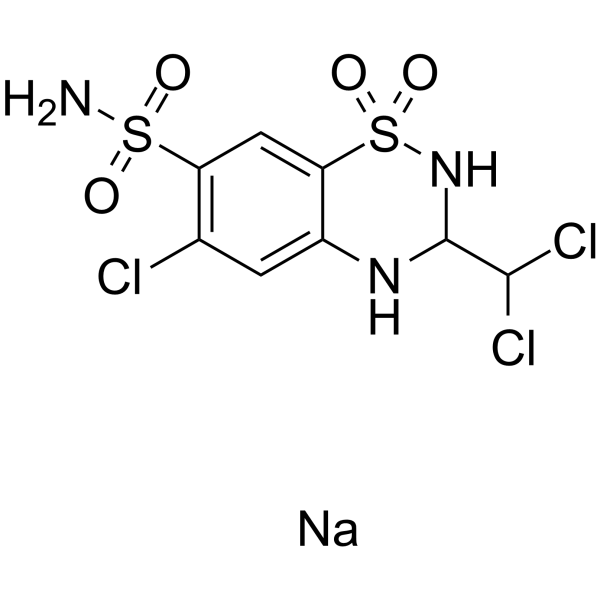Trichlormethiazide sodium
Modify Date: 2024-07-21 07:54:38

Trichlormethiazide sodium structure
|
Common Name | Trichlormethiazide sodium | ||
|---|---|---|---|---|
| CAS Number | 91996-54-2 | Molecular Weight | 403.65 | |
| Density | N/A | Boiling Point | N/A | |
| Molecular Formula | C8H8Cl3N3NaO4S2 | Melting Point | N/A | |
| MSDS | N/A | Flash Point | N/A | |
Use of Trichlormethiazide sodiumTrichlormethiazide sodium is an orally active thiazide diuretic, with antihypertensive effect. Trichlormethiazide sodium increases urine volume (UV), Na and K excretion and tends to improve the depressed creatinine clearance (CCRE) in acute renal failure rats model[1][2]. |
| Name | Trichlormethiazide sodium |
|---|
| Description | Trichlormethiazide sodium is an orally active thiazide diuretic, with antihypertensive effect. Trichlormethiazide sodium increases urine volume (UV), Na and K excretion and tends to improve the depressed creatinine clearance (CCRE) in acute renal failure rats model[1][2]. |
|---|---|
| Related Catalog | |
| In Vivo | Trichlormethiazide (1 mg/kg; p.o.; once) sodium increases urinary volume, sodium and potassium excretion in rats[1]. Trichlormethiazide (10 mg/kg, i.v.; daily for 5 days) sodium significantly reduces mean arterial pressure (MAP) within 24 h in high salt intake (HS) rats receiving angiotensin II, but does not affect MAP in any other group[2]. Animal Model: Male Wistar rats, weighing 170-300 g[1] Dosage: 1 mg/kg Administration: Oral administration, once Result: Significantly increased potassium excretion in normal rats. Significantly increased urinary volume, sodium and potassium excretion in cisplatin-induced ARF (acute renal failures) rats. Animal Model: Male Sprague-Dawley rats (350-450 g)[2] Dosage: 10 mg/kg Administration: Intravenous injection, daily, for 15 days Result: Produced a significant fall in MAP in rats on combined angiotensin II and high salt intake. |
| References |
| Molecular Formula | C8H8Cl3N3NaO4S2 |
|---|---|
| Molecular Weight | 403.65 |